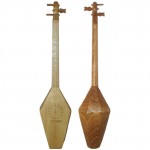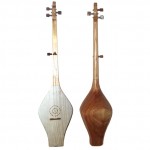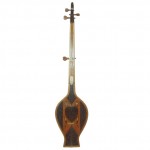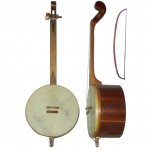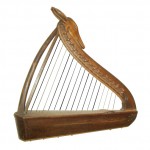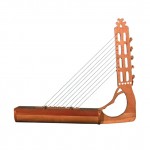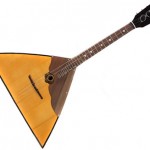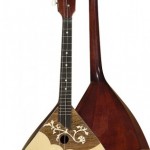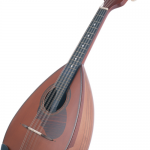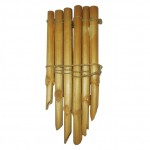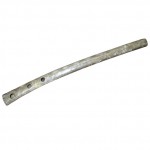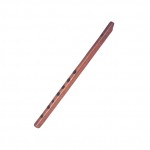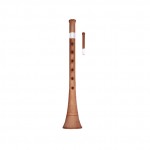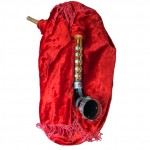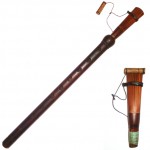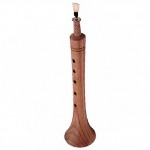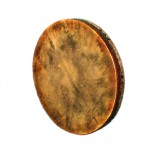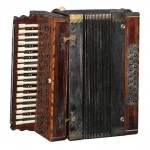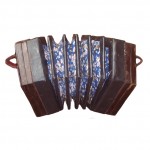Today, many kinds of musical instruments are popular in Georgia, including wind, string, percussion and keyboard instruments. Those of non- Georgian origin have adopted traditional Georgian characteristics. We know the following instruments to be of Georgian origin based on knowledge of their production, as well as existing sayings and legends about their origins, functions and musical semantics:
Wind instruments: larchemi-soinari, salamuri, pilili, gudastviri and stviri
Brass wind instruments: sankeri
String instruments: panduri, chonguri, chianuri and changi
Percussion instruments: doli, daira and diplipito
Non-Georgian instruments such as the duduki, zurna, balalaika, mandolin and garmoni were introduced in Georgia in 17th -18th centuries and soon became popular. They underwent changes in both construction and tuning to correspond with Georgian musical language.
Georgian instruments were born within Georgian song and subsist on it. From the standpoint of musical language, we do not find any form of Georgian instrumental music that is not also reflected in Georgian vocal art. However, not even the richest instrument can express the complex development of Georgian folk song.
Georgian instrumental music, like Georgian song, comprises a vertical performance in one to four voices. As in song, three-voiced construction is most frequent, performed on panduri, chonguri, chianuri, changi, balalaika, garmoni and tsiko-tsiko. Two-voiced construction is comparatively rare, performed on larchemi-soinari, on the Kartlian, Rachan, Acharan and Pshavian gudastviri, on two-stringed panduri and chianuri, and on duduki and zurna. The melody of one duduki is generally accompanied by one or two others, thus creating two- or three-voiced performance; likewise, the melody of one zurna is usually accompanied by the bass drone of another zurna, resulting in two-voiced performance. We also find four-voiced performance on chonguri, and one-voiced performance on salamuri, pilili, stviri and tulumi.
In Georgia, instruments are generally used to accompany songs and dances. There are few solo instrumental performances.
Performance by voice and instrument together is regulated in Georgian traditional life. Some songs are performed without instrumental accompaniment (table songs, work songs, Gurian polyphonic songs, etc.), while some instruments are used exclusively for solo performance (larchemi-soinari, salamuri, pilili and sankeri).
In a traditional Georgian musical environment songs and dances are accompanied by one instrument at a time (panduri, chonguri, chianuri, gudastviri, chiboni, daira, doli, diplipito, tsiko-tsiko or garmoni) or two instruments of two various kinds played at a time (panduri and salamuri, chonguri and doli, chianuri and changi, chiboni and doli, salamuri and doli, or garmoni and doli).
The duduki and zurna, instruments of non-Georgian origin, are played only in ensembles (two dudukis and one doli, one duduki and one daira, or two zurnas and one doli).
Some instruments are played by either men or women (panduri, chonguri, chianuri, changi, mandolin, balalaika and garmoni). However, some instruments are played only by men (salamuri, pilili, larchemi-soinari, gudastviri, doli, diplipito, duduki and zurna) and others by women (daira, tsiko-tsiko).
In Georgian musical life there are skilled masters whose instrumental performance goes far beyond the borders of folk musical practice, distinguished by virtuosity.
String Instruments
Panduri
a three-stringed lute (played by strumming) from the highland and lowland regions of Eastern Georgia, and rarely found in Western Georgia ( Upper Imereti and Racha). The two-stringed panduri survives in Khevsureti.
Tuning of the three-stringed panduri: g – a – c1
Tuning of the two-stringed panduri: d – c1
Chonguri
a four-stringed lute (played by plucking and strumming) from Western Georgia. Three of the strings are fingered, while the fourth is a drone string. It is mainly found in Samegrelo, Abkhazia, Imereti, Guria and Achara, and rarely in Lechkhumi.
Three types of tuning, out of several, have survived:
1) f – a – c 1 – f1
2) f – a – c1 – e1
3) f – g – c1 – g1
Chuniri – Chianuri
a bowed, three-stringed viol-type instrument from Svaneti (where it is called the chuniri), Racha, Khevsureti and Tusheti. In Racha there is also a two-stringed chianuri.
Tuning of the three-stringed chuniri or chianuri: as – b – des1.
Tuning of the two-stringed chianuri: as – c1.
Changi
a six- or seven-stringed angular harp (played by plucking) from Svaneti.
Tuning of the six-stringed changi: f – g – a – h – c1 – d1.
Tuning of the seven-stringed changi: e – f – g – a – h – c1 – d1.
Balalaika
a three-stringed instrument (played by strumming) played in the highland regions of Eastern Georgia.
Tuning of the balalaika: g – a – c1.
Mandolin
a three-stringed instrument (played by strumming) played in the highland regions of Eastern Georgia.
Tuning of the mandolin: g – a – c1.
Wind Instruments
Larchemi-Soinari
Georgian panpipe from Samegrelo and Abkhazia (where it is called larchemi) and Guria (called soinari). The larchemi-soinari has six pipes. Sometimes the pipes of larchemi are shared by two performers.
Tuning of the larchemi-soinari entirely depends on the maker’s ear.
Here is the tuning of two different larchemis according to the order of pipes:
h2 – gis2 – fis2 – gis2 – ais2 – cis3;
h2 – fis2 – dis2 – cis2 – e2 – h2.
Salamuri
a flute from Eastern Georgia mainly found in Kartli, Kakheti, Meskheti, Tusheti and Pshavi.
It may be tongueless (with 5 or 6 finger holes) or tongued (with 6 or 7 finger holes).
Tuning of the tongueless salamuri with 5 finger holes: a1 – h1 – cis2 – d2 – e2 – f2.
Tuning of the tongueless salamuri with 6 finger holes: e1 – fis1 – g1 – a1 – h1 – c2 – d2.
Tuning of the tongued salamuri with 7 finger holes: h – c1 – d1 – e1 – f1 – g1 – a1 – h1 (c2 – d2 – es2 – f2 – g2 – a2 – h2 – c3 when overblowing)
Tuning of the tongued salamuri with 6 finger holes: e1 – fis1 – g1 – a1 – h1 – c2 – d2 (e2 – fis2 – g2 – a2 – h2 – c3 – d3 when overblowing)
Pilili
a pipe from Achara with 5-7 finger holes.
Tuning of the pilili: des1 – es1 – f1 – ges1 – as1 – b1 – c2.
Gudastviri
a bagpipe from Kartli, Racha, Achara (where it is called chiboni), Meskheti (where it is called tulumi) and Pshavi. They differ from one another in timbre, capacity / size of the bag and number of holes on the two pipes.
Tuning of the Kartlian gudastviri:
Pipe I: c1 – d1 – es1 – f1 – g1 – as1 – b1.
Pipe II: c1 – d1 – es1 – f1.
Tuning of the Rachan gudastviri:
Pipe I: c1 – d1 – es1 – f1 – g1 – as1 – b1.
Pipe II: c1 – d1 – es1 – f1.
Tuning of the Acharan chiboni:
Pipe I: e1 – fis1 – g1 – a1 – h1 – cis2.
Pipe II: e1 – fis1 – g1 – a1.
Tuning of the Meskhetian tulumi:
Pipe I: e1 – fis1 – g1 – a1 – h1.
Pipe II: e1 – fis1 – g1 – a1 – h1.
Tuning of the Pshavian gudastviri:
Pipe I: c1 – d1 – es1 – f1 – g1 – as1 – b1.
Pipe II: c1 – d1
Duduki
a double-reed shawm-like instrument once popular in the towns of Eastern Georgia still common in Tbilisi today. It has 8 finger holes above and one finger hole below.
Tuning of the duduki: g – a – b – c1 – d1 – es1 – f1 – g1.
Zurna
a wind instrument with a single reed popular in the towns of Eastern Georgia and also in Kartlian villages. It has 7 or 8 finger holes above and one finger hole below.
Tuning of the zurna: a1 – h1 – cis2 – d2 – e2 – fis2 – gis2 – a2.
Percussion instruments
Doli
a double-headed drum popularin lowland regions of Eastern and Western Georgia.
Daira
a frame drum popular in Kartli, Kakheti, Tusheti, Samegrelo, Racha and Imereti.
Keyboard instruments
Garmoni
a type of diatonic button accordion popular in Eastern Georgia, especially in Tusheti
Tsiko-tsiko: a kind of concertina popularmainly in Kartli.

